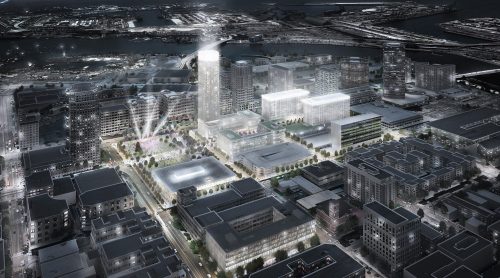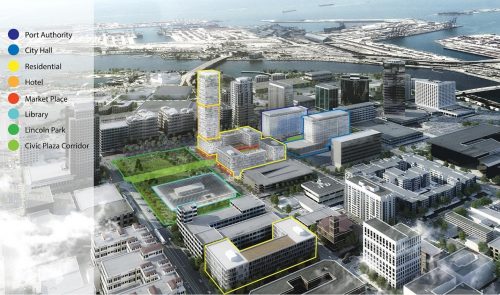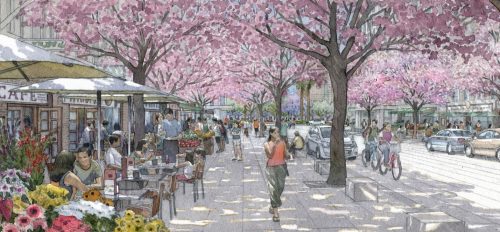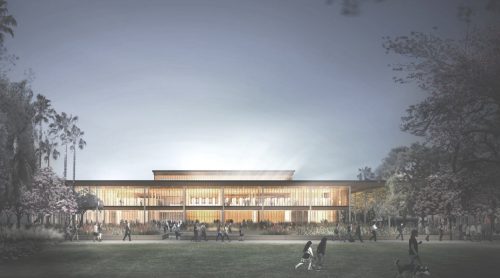(Image Courtesy: Plenary Edgmoor)
The new civic center of Long Beach, California currently under construction at a cost of over $500 million, is the largest public-private development of its kind on the West Coast. It is also the result of a city’s long-term commitment to revitalization spanning over a decade and a reflection of its continued dedication to community improvement through development.
Long Beach California has seen its share of decline. In fact, decades of it. The waterfront city has the largest port in the United States neighboring the Port of Los Angeles and was once a resort destination lined with historic high rises along Ocean Avenue. The city’s frayed edges began to unravel decades before the Global Financial Crisis. In the 1970s, Long Beach faced a steady flight of major businesses including national retailers and ranked as having one of the worst downtown cores. It was also during this time that a new civic center was dedicated in 1976. The city hall and library were built in Brutalist style, with imposing concrete facades surrounding Lincoln Park. The design of the municipal center closed off former streets to create a vehicle-free square. Rather than attract public interaction with the civic space, the center and its surrounding downtown region became areas to avoid as violent crimes increased year after year. By 1990, over 100 homicides were reported annually, while aggravated assaults totaled over 4,400 incidents.
In the last twenty years, Long Beach made concerted efforts to redevelop its ailing downtown core and tackle blight throughout the city. The former Long Beach Redevelopment Agency (LBRDA) controlled 259 parcels of land at 71 different sites valued at over $1.28 billion and received funds from the State of California. After the Great Recession, the state shut down approximately 400 redevelopment agencies including LBRDA to close a multibillion dollar budget gap. The city successfully pushed the state to transfer holdings belonging to the Redevelopment Agency under the control of the City Council. From this point, Long Beach accelerated efforts to sell parcels of land to developers who would build according to the city’s long-term development plan. Within a few years, Long Beach sold 27 parcels primarily in the downtown region. State funding was now a tenuous option for redevelopment and the city needed to find creative ways to finance its aggressive plan to revitalize downtown estimated at over $3.5 billion. The centerpiece and most ambitious of these projects is the new civic center. In order to spur development, Long Beach orchestrated a public-private funding model.
(Image Courtesy: SOM)
Unlike traditional public projects raised through selling bonds, increasing taxes, or dipping into the city’s general fund, the new civic center is financed privately. Developers have committed to spending $520 million dollars in public buildings and a city park in exchange for land allowing profit-driven projects including office space, retail, condominiums and apartments.
Mid-Block Commercial Area (Image Courtesy: SOM)
The new civic center area under construction will cover 22 acres in downtown including the 93,500 square foot Main Library, the 270,000 square foot City Hall, and the 232,000 square foot Port Headquarters. Future developments are still in the pipeline with a total cost of nearly $900 million. Breaking from the current civic center’s insular design, the new center will incorporate mixed-use developments alongside public offices which include a 35-story residential tower, 50,000 square feet of commercial development, room for a luxury hotel, and the reopening of Lincoln Park. All buildings are targeted to have LEED Gold Certifications and the plan has pedestrian passageways as a priority by creating plazas and promenades along generously allocated green space. The plan will also open up three streets that were previously blocked by the current civic center.
(Image Courtesy: SOM)
Main Library (Image Courtesy: Plenary Edgmoor)
The private developer partnered with the city is Plenary-Edgmoor which consists of multiple partner companies, and the project itself is a coalition of nine partners with 13 separate agreements. Plenary-Edgmoor will design, build, finance, operate, and maintain the project with SOM as the architect. In addition, Plenary-Edgmoor will operate the three public facilities for 40 years (until 2059), with the city of Long Beach paying $13.5 million a year annually. This amount is about the same as what the city pays to operate and pay debt service for its current civic center. The annual payments will primarily come from the city’s general funds and taxes generated from filming permits. After the 40-year period, the city will take full control of its public buildings. For Plenary-Edgmoor, the city’s annual payments will help pay down its leverage (including loans from insurance companies) and contribute to operating and maintenance costs. The bulk of the developer’s funding is through private capital from large institutional investors including REITs and the sale of CMBS.
The new Civic Center is attracting the attention of other cities throughout the country looking to develop without raising taxes. Officials from cities including Charlotte, NC have visited the site and are studying the collaborative financing involved to possibly replicate in their own municipalities. The project serves as an innovative example of public-private partnerships on a large urban scale. It also represents a financing model that may soon be adopted by more civic governments creating new opportunities in development for public officials, developers, and investors.





